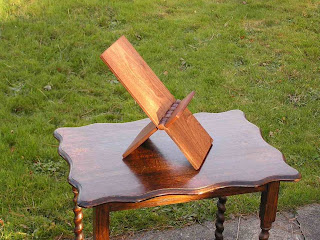The iPad stand I used to carve for clients as part of the Custom Desk business from African sapele wood is based on an 18th century French design described by André Roubo.
This stand is cut from a single board, uses no hardware, the hinge is marked out and carved by hand, then the ends are ripsawn down the sides of the board to the hinge.
Roy Underhill, of the PBS series The Woodwright's Shop, wrote a great article in Popular Woodworking Magazine (February 2011 #188) about Roubo and the original bookstand called "Roubo's Folding Bookstand". I recommend you buy a copy of the magazine at http://www.popularwoodworking.com/feb11 to read this.
As a woodworker it was impossible for me to read this piece without trying to make the hinge. The first one I made from a square piece of pine actually worked! Needing to find a use for it I designed an adjustable laptop stand where the hinge is part of the adjusting mechanism (see http://buildingdesks.blogspot.com/2012/07/adjustable-laptop-stand.html).
My iPad stand is closer to Roubo's bookstand design in shape than my adjustable laptop stand. When opened the back is tall to support the back of the iPad, whether used vertically or horizontally. The front is shortened to provide a lip that supports the base of the iPad, and gives your fingers somewhere to sit when not working at the touchscreen.
Unlike the elegant curves used on the legs and back of Roubo's bookstand, the iPad stand is rectangular with the only decoration being chamfered edges. This was a practical decision as well as an aesthetic one. The rectangular legs keep the stand stable if used on a less-than-flat surface, and the back gives good support to the iPad in use.
Since first writing this piece, the episode of The Woodwright's Shop on making Roubo's bookstand has become available to view online - see http://www.pbs.org/woodwrightsshop/video/3100/3101.html.

I found that The Woodwright's Shop wasn't available through the PBS iPad App.
ReplyDeleteI wrote to PBS and they've now added 7 episodes and plan to add more!
http://www.metmuseum.org/Collections/search-the-collections/140003346?rpp=20&pg=3&ft=*&deptids=14&what=Furniture&pos=50
ReplyDeleteDated 1360AD
Some more old examples of the book stand.
http://mihrabislamicart.com/artOfWoodArtifcats.htm
I think it was sloppy of Underhill to attribute it to Roubo(though he did say it was not invented by him). Writing about it in a book should not be a reason that an object is attributed to a person.
This is a common article which most Muslims will receive at least once in his lifetime as a gift. From South Asia, Central Asia, Middle East, most of Africa, and many countries in Far East are familiar with this kind of book stand. It can be safely said that 2 billion plus people will know it as a Qur'an/religious book stand.
These are still made by hand mostly. Available even in US every major city has an Islamic books store which will have one. Else you can find online in US based Islamic book stores or even on ebay and Amazon.
Many thanks for this information!
DeleteIt is so great to learn this elegant hinge is not only much older as a design, but is still being made and used.
The Qur'an stands you've linked to are beautiful with stunning carving, and the X-shape makes much better sense to support a precious book.
When I've carved a hinge and opened it up, it has always seemed a shame to cut one of the top wings off.
The laptop stands I've made keep the wings in place, and these looked better to me, but I didn't really know why.
I was sad to think not many people were making these, when they have clearly been constantly in production, and for a better purpose than I had imagined.
If it hadn't been for Roy Underhill's article I wouldn't have been inspired to try making the remarkable hinge, but your post is a lesson to me to widen my scope of reading about woodworking. Which sources you would recommend relating to Islamic woodwork?